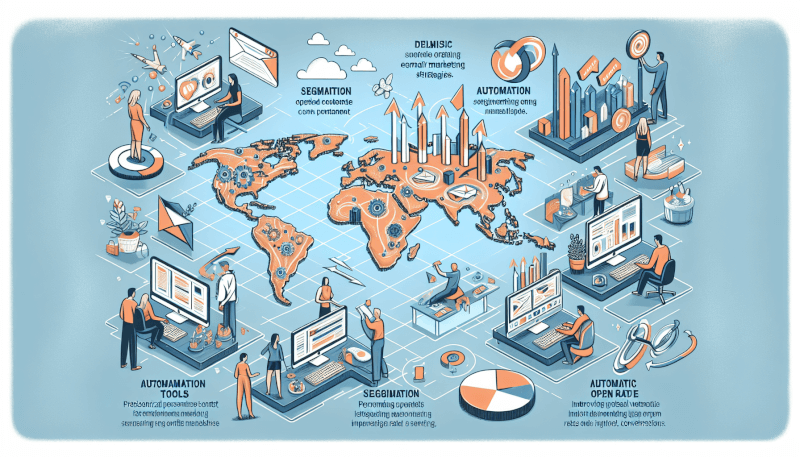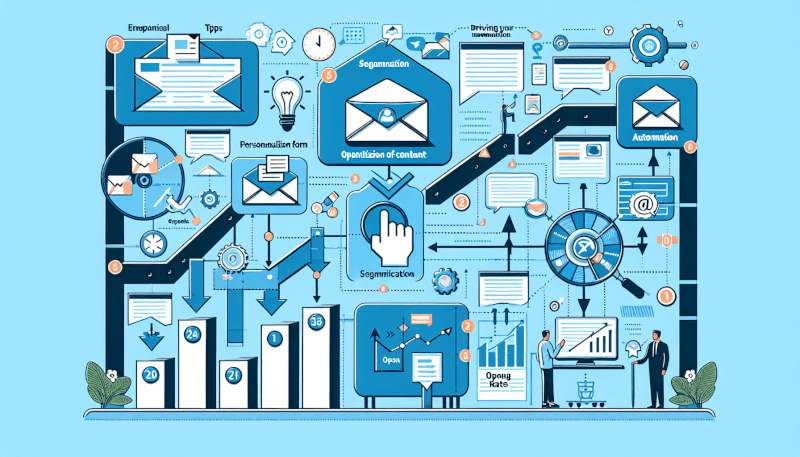In today’s digital age, email marketing has emerged as a powerful tool for businesses to connect with their audience and nurture lasting relationships. But how do you engage and retain your subscribers amidst the constant barrage of emails? This article explores effective email marketing strategies that will captivate your subscribers, keep them interested, and ultimately drive business growth. From creating compelling content to personalizing emails, these strategies will help you stand out in the inbox and foster a loyal subscriber base. Read on to discover the key techniques that will take your email marketing game to the next level.
Segmentation and Personalization
Understanding your audience
Understanding your audience is essential when it comes to successful email marketing. By knowing who your subscribers are, you can tailor your emails to meet their specific needs and interests. Take the time to gather information about your subscribers, such as their demographics, preferences, and behaviors. This will allow you to create targeted content that resonates with them and increases engagement.
Segmenting your subscribers
Segmenting your subscribers involves dividing your email list into smaller, more targeted groups based on specific criteria. This allows you to send personalized content to each segment, increasing the chance of engagement. Common segmentation criteria include demographics, purchase history, and engagement level. By segmenting your subscribers, you can send more relevant and tailored emails, leading to higher open rates, click-through rates, and conversions.
Personalizing your emails
Once you’ve segmented your subscribers, it’s time to personalize your emails. Personalization can be as simple as including the subscriber’s name in the email or as complex as sending highly targeted content based on their past interactions with your brand. By using personalization techniques, you show your subscribers that you understand their needs and value their relationship with your brand. This, in turn, leads to higher engagement and improved customer loyalty.
Optimize Email Content
Craft compelling subject lines
The subject line is the first thing your subscribers see in their inbox, so it’s crucial to make it compelling and engaging. A compelling subject line grabs the reader’s attention and entices them to open the email. To create a compelling subject line, use action-oriented words, create a sense of urgency or exclusivity, and be concise and to the point. Experiment with different subject lines and use A/B testing to determine which ones resonate best with your audience.
Create engaging email copy
Once your subscribers open your email, it’s important to keep them engaged with well-crafted email copy. Use a conversational tone and make the content personalized and relevant to each segment. Keep the email content concise and well-structured, making it easy for subscribers to scan and understand the key points. Use persuasive language to encourage action and include a clear call-to-action that leads to the desired outcome, whether it’s making a purchase, signing up for an event, or reading a blog post.
Incorporate visuals and multimedia
Visuals and multimedia can significantly enhance the impact of your emails. Use eye-catching images, videos, and gifs to capture your subscribers’ attention and make your emails visually appealing. Make sure the visuals are relevant to the content and consider using personalized images or product recommendations based on each subscriber’s preferences. However, be mindful of the file size to ensure fast loading times, especially for mobile users. Additionally, provide alternative text for visually impaired subscribers and ensure your emails look great even if images are disabled.

Mobile-Friendly Design
Responsive email templates
With the increasing number of people accessing emails on mobile devices, it’s crucial to make your emails mobile-friendly. Use responsive email templates that automatically adapt to different screen sizes and devices. This ensures that your emails are easily readable and visually appealing on smartphones and tablets. Test your emails on various devices and email clients to ensure a seamless experience for all subscribers.
Short and scannable content
When it comes to mobile devices, attention spans are often shorter. Therefore, it’s important to keep your email content concise and scannable. Use short paragraphs, bullet points, and subheadings to break up the text and make it easy for subscribers to skim through the email. Highlight the most important information and ensure that it stands out even when scrolling quickly. By keeping your content short and scannable, you increase the chances of capturing and retaining your subscribers’ attention.
Call-to-action buttons optimized for mobile
To encourage conversions on mobile devices, optimize your call-to-action (CTA) buttons. Make sure they are large enough to be easily tapped with a finger and provide enough spacing to prevent accidental clicks. Use contrasting colors to make the buttons stand out and clearly state the desired action. Test the CTAs on various mobile devices and screen sizes to ensure a smooth user experience.
Automation and Drip Campaigns
Implementing automated email workflows
Automation allows you to streamline your email marketing efforts and deliver personalized content at scale. By implementing automated email workflows, you can send targeted emails based on specific triggers or actions taken by your subscribers. For example, you can set up a welcome email series for new subscribers or send a follow-up email to those who made a purchase. Automation saves time and ensures that your subscribers receive the right content at the right time.
Nurturing leads with drip campaigns
Drip campaigns are a type of automated email campaign that involves sending a series of scheduled emails to nurture leads and move them through the customer journey. Each email in the drip campaign is strategically designed to provide valuable information, address pain points, and guide the subscriber toward taking the desired action. Drip campaigns help build relationships, increase engagement, and ultimately, drive conversions.
Trigger-based emails
Trigger-based emails are sent in response to specific actions or behaviors exhibited by your subscribers. For example, you can send a trigger-based email to subscribers who abandoned their shopping cart or those who haven’t engaged with your emails for a certain period. By leveraging trigger-based emails, you can re-engage inactive subscribers, recover lost sales, and make your email marketing efforts more relevant and timely.

Email Frequency and Timing
Determining the ideal email frequency
Finding the right email frequency is important to avoid overwhelming your subscribers or becoming overlooked in their inbox. The ideal email frequency depends on your audience, industry, and the type of content you deliver. Monitor your subscribers’ engagement levels and use A/B testing to find the sweet spot that keeps your audience interested without causing email fatigue. Strike a balance between being present in your subscribers’ inbox and respecting their time and attention.
Testing and analyzing open rates
Testing and analyzing open rates can provide valuable insights into the effectiveness of your email campaigns. A/B test different subject lines, email content, and send times to gauge the impact on open rates. Pay attention to trends and patterns in open rates to understand what resonates with your audience. Continuously optimize your email content and strategies based on the data you collect.
Segmenting based on engagement time
Segmenting your subscribers based on their engagement time allows you to tailor your approach to each segment. For example, you can create a segment for highly engaged subscribers who regularly open and click on your emails, and another segment for less engaged subscribers. By segmenting based on engagement time, you can send more targeted emails, such as exclusive offers or re-engagement campaigns, to rekindle or maintain interest.
Retargeting and Re-engagement Campaigns
Segmenting inactive subscribers
Not all of your subscribers will remain actively engaged with your emails. However, rather than letting them slip away, you can implement retargeting and re-engagement campaigns to bring them back into the fold. Segment your inactive subscribers and send targeted emails designed to reawaken their interest. Highlight any new features, products, or content that may appeal to them, and include a strong call-to-action to encourage their participation.
Sending targeted re-engagement emails
Re-engagement emails are an effective way to remind inactive subscribers of the value your brand offers. Craft personalized emails that acknowledge their absence and offer incentives to re-engage. Consider offering exclusive discounts, freebies, or access to premium content. Make the email visually appealing, concise, and compelling, with a clear call-to-action that motivates them to take action and rediscover why they initially subscribed.
Using retargeting ads
In addition to email campaigns, you can also employ retargeting ads to re-engage inactive subscribers. Retargeting ads display targeted ads to individuals who have visited your website or engaged with your brand in the past but have not converted into customers. By using retargeting ads, you can subtly remind them of your brand and entice them to return to your website or take the desired action.

Integrate Social Media
Adding social sharing buttons
To expand your email reach and encourage engagement, it’s important to integrate social media into your email marketing strategy. Include social sharing buttons within your emails, allowing subscribers to easily share your content on their social media platforms. This can help increase your brand’s visibility, attract new subscribers, and drive traffic back to your website.
Utilizing user-generated content
User-generated content (UGC) is a powerful way to engage your audience and build social proof. Encourage your subscribers to share their experiences, photos, or testimonials and incorporate them into your email campaigns. Share UGC that highlights your products or services, showcasing how they have positively impacted your customers’ lives. By utilizing UGC, you create a sense of community and authenticity, attracting more subscribers and fostering trust.
Running exclusive email campaigns
Running exclusive email campaigns that are only available to your subscribers can help create a sense of exclusivity and value. Offer special discounts, limited-time offers, or early access to new products or content. By providing unique benefits to your subscribers, you make them feel appreciated and increase their loyalty to your brand. Promote these exclusive campaigns through your social media channels to attract more subscribers and grow your email list.
Provide Valuable and Relevant Content
Creating informative and educational content
Delivering valuable and relevant content is key to keeping your subscribers engaged and interested in your emails. Create content that educates, informs, and solves problems for your audience. Offer helpful tips, industry insights, or how-to guides that align with your subscribers’ interests and goals. By positioning yourself as a trusted source of information, you build credibility and maintain a strong relationship with your subscribers.
Offering exclusive discounts and promotions
Exclusive discounts and promotions are a great way to reward your subscribers and keep them engaged. Offer special discounts or promotions that are available only to your email subscribers. This incentivizes them to stay subscribed and provides added value for their loyalty. Make sure to clearly communicate these exclusive offers and highlight the benefits they provide, such as cost savings or early access to sales.
Tailoring content to subscribers’ preferences
To truly engage your subscribers, it’s important to tailor your content to their preferences. Use the information you gather from segmentation to customize the content you send to each segment. For example, if a segment primarily consists of young professionals, focus on topics that resonate with their career growth or work-life balance. By aligning your content with their interests and goals, you increase the chances of capturing their attention and fostering a long-term relationship.

Personalize the Unsubscribe Process
Asking for feedback
When a subscriber decides to unsubscribe from your emails, take the opportunity to ask for feedback. Include a brief survey or a comment box in your unsubscribe page to understand their reasons for leaving. This feedback can provide valuable insights into any potential issues with your email content or communication strategy. Additionally, it shows your commitment to improving and provides an opportunity to address any concerns, potentially preventing them from fully unsubscribing.
Providing alternative subscription options
Sometimes a subscriber may wish to reduce the frequency of emails rather than completely unsubscribe. Provide alternative subscription options on your unsubscribe page, such as a monthly newsletter or a digest of your top content. By offering this alternative, you may be able to retain some subscribers who still value your brand but desire fewer emails. It’s crucial to respect and accommodate their preferences to maintain a positive relationship.
Using exit surveys
Exit surveys are another valuable tool for understanding why subscribers choose to leave. Implement an exit survey during the unsubscribe process to gather more detailed feedback. Ask questions about the relevance of content, frequency of emails, and overall satisfaction with the emails they received. This information can help you make strategic improvements to your email marketing campaigns and reduce future unsubscribe rates.
Monitor and Analyze Results
Tracking email metrics
To gauge the success of your email marketing efforts, it’s important to track key email metrics. Monitor metrics such as open rates, click-through rates, and conversion rates to measure the effectiveness of your campaigns. Analyze these metrics regularly and compare them to industry benchmarks to identify areas for improvement. By tracking email metrics, you can make data-driven decisions to optimize your strategy and achieve better results.
Implementing A/B testing
A/B testing involves sending two different versions of an email to a portion of your subscriber base and analyzing the performance of each version to determine which one performs better. Test various elements, such as subject lines, email content, visuals, or call-to-action buttons, to see which version resonates best with your audience. A/B testing allows you to optimize your emails based on data and continually improve your email marketing strategy.
Adjusting strategies based on data
All the data you collect from monitoring email metrics and A/B testing should guide your decision-making process. Use the insights gained from the data to adjust your email marketing strategies. If you notice certain types of content or subject lines have higher engagement rates, incorporate more of those elements into your future emails. Continuously adapt and refine your strategies based on the data you gather to ensure your email marketing efforts are effective and relevant to your audience.
In conclusion, implementing effective email marketing strategies requires a deep understanding of your audience, segmentation, personalization, optimization of email content, mobile-friendly design, automation, timing, retargeting, social media integration, valuable content, personalized unsubscribe process, and continuous monitoring and analysis. By following these strategies, you can engage and retain your subscribers, build strong relationships with them, and achieve better results with your email marketing campaigns.



